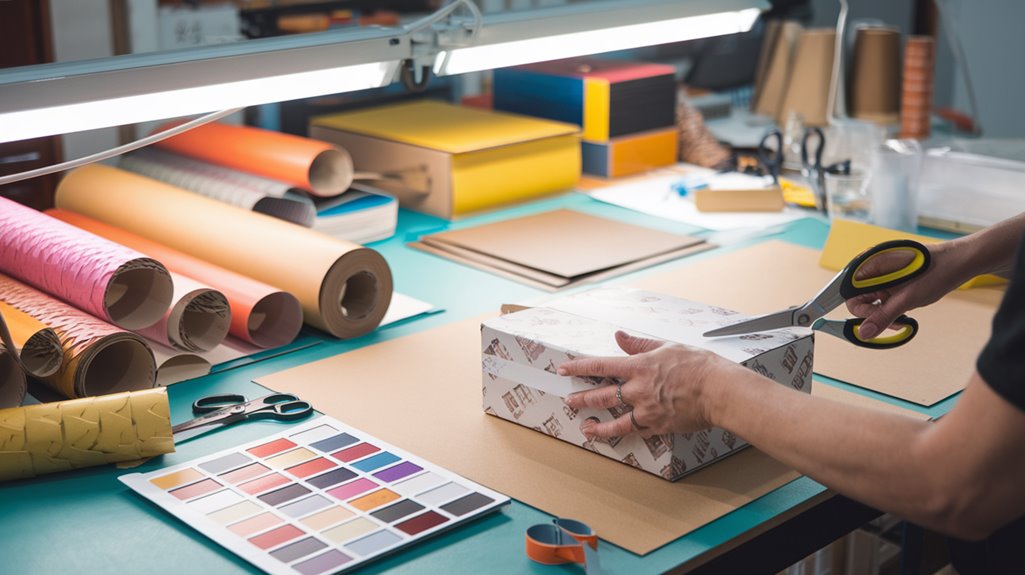
To create custom cart packaging solutions, start by evaluating your product's size, weight, and fragility. Choose durable and sustainable materials that reflect your brand values. Next, consult with stakeholders to plan your design while considering your target audience and eco-friendly options. Develop design concepts that align with your brand identity and gather feedback through prototypes. Guarantee quality assurance by testing materials and simulating delivery conditions. By following these steps, you'll enhance your packaging's appeal and effectiveness. Stay tuned to discover more strategies for refining your custom packaging solutions and staying ahead of market trends.
Main Points
- Assess product specifications like size, weight, and fragility to determine suitable packaging solutions.
- Consult with stakeholders to outline project goals, budgets, and sustainability objectives for custom packaging.
- Develop design concepts that reflect the brand identity and resonate with the target audience's preferences.
- Create prototypes and gather feedback from stakeholders to refine designs and ensure quality standards are met.
- Implement quality assurance measures, including durability testing and inspections, before finalizing the packaging for production.
Assessing Packaging Requirements
How do you guarantee your products arrive safely at their destination?
Start by evaluating packaging requirements based on product size, weight, and fragility.
Choose durable, sustainable packaging materials that align with your brand values and meet consumer preferences.
Consider the environmental impact of your choices, as eco-friendly options appeal to 58% of shoppers, enhancing your packaging design while minimizing waste. Additionally, incorporating sustainable materials can significantly reduce environmental impact and foster brand goodwill.
Consultation and Planning
After evaluating your packaging requirements, the next step involves consultation and planning to create effective custom cart packaging solutions.
Schedule an initial consultation to discuss project needs and budget constraints. Analyze competitors' strategies to identify design differentiators and gather insights on your target audience.
During the planning process, evaluate sustainability goals and select packaging materials that enhance customer engagement while aligning with eco-friendly initiatives. Additionally, prioritize custom packaging that not only enhances brand identity but also appeals to environmentally conscious consumers.
Design Concept Development
To create a successful design concept for your custom cart packaging, start by understanding your target audience's preferences, interests, and values, as this will guarantee your design resonates effectively.
Conduct a competitor analysis to inspire unique aesthetics. Incorporate your brand identity through cohesive design elements.
Utilize design tools to create visual representations, and gather feedback to refine your packaging design for an enhanced customer experience. Additionally, consider using eco-friendly boxes as a sustainable option that aligns with current market trends.
Prototyping and Feedback
While you're developing your custom cart packaging, prototyping serves as an essential step that brings your design concepts to life. Engage stakeholders in feedback sessions to gather insights on user experience and market preferences. Conduct durability testing to verify your packaging meets quality standards. Final approval confirms alignment with brand objectives, paving the way for a smooth production process. Additionally, incorporating custom printed options can significantly enhance your packaging's market appeal.
Material Selection
Material selection is a critical factor in creating effective custom cart packaging that protects products while also representing your brand.
Choose durable materials like corrugated cardboard or biodegradable plastics to withstand transit.
Incorporate recycled materials to appeal to eco-conscious shoppers.
Don't forget to test material samples and utilize advanced printing technologies for enhanced brand representation and packaging solutions that truly protect your product. Additionally, consider using biodegradable materials to reduce environmental impact and align with sustainable practices.
Production Process
Once you've selected the right materials for your custom cart packaging, the production process kicks into gear.
You'll collaborate with manufacturers to establish efficient production timelines while adhering to quality standards.
Utilize advanced printing technologies for enhanced brand recognition, and implement quality control measures.
Conduct thorough inspections and testing samples to guarantee the packaging meets both functional and aesthetic requirements before shipping.
Quality Assurance and Testing
Quality assurance in custom cart packaging is essential for delivering reliable and effective products to your customers.
By implementing quality control measures, you can perform thorough inspections and test materials for consumer safety.
Simulating delivery conditions guarantees packaging durability and minimizes product damage.
Utilizing feedback loops and staying attuned to market trends enhances design effectiveness, ultimately increasing customer satisfaction and loyalty.
Conclusion
In summary, creating custom cart packaging solutions involves understanding your packaging needs, collaborating on designs, and selecting the right materials. By following the steps from consultation to quality assurance, you can guarantee your packaging not only protects your products but also enhances your brand's image. Don't underestimate the impact of well-designed packaging—it's a key factor in customer satisfaction. Now, take these insights and start crafting your unique packaging solution that stands out!

